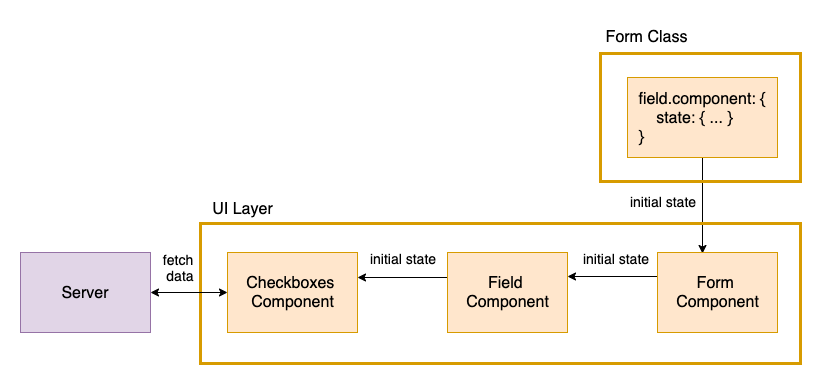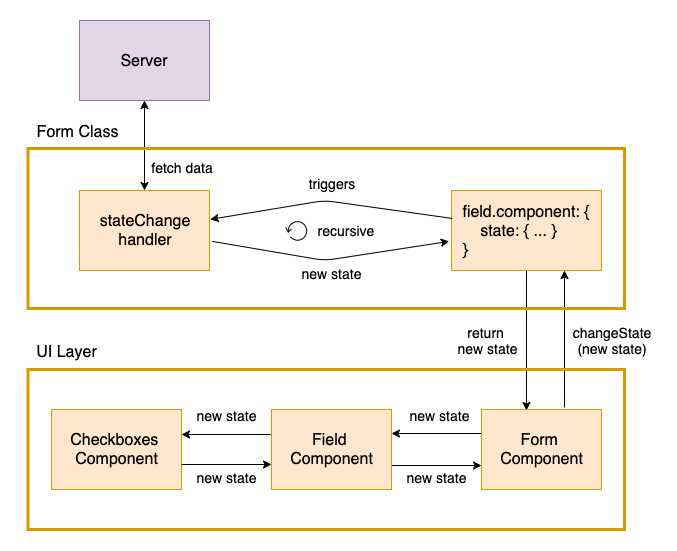Component
UI component for a field to use, such as DatePicker, Text, Number and and custom component.
Component can be editable (like Checkboxes) or readonly (like Label).
Each UI library can define a set of properties api which it will take data from the current form instance and
inject it to its Field's components (properties like the component value, if its disabled, required and more).
For example, @jafar/react-components API is defined in here.
Field Component
To define field component - a component definition is required in the model object, and implementation is required in resources object.
Model
model.fields.someField.component - object. Contains:
| Name | Type | Description |
|---|---|---|
| name | required string | Represents a key in resources.components object where actual UI components are defined |
| value | any | Represent the current formatted (if formatter exists) view value of the component. Auto generate by the Form lifecycle |
| state | object | Reflects the current component state data. |
Resources
resources.components - object. Required only if model.fields.someField.component defined in at least one of the fields.
Key is the component name and value is an object which contains:
| Name | Type | Description |
|---|---|---|
| renderer | any | Actual UI component |
| stateChange | function | Triggers when state changes. Manage state changes outside of the ui component when using stateless component. More info |
Example
import InputText from '../my-components/InputText';
import Checkboxes from '../my-components/Checkboxes';
const model = {
fields: {
firstName: {
// ...
component: {
name: 'InputText',
state: {
placeholder: 'Enter name',
},
}
},
hobbies: {
// ...
component: {
name: 'SelectItems',
state: {
searchFilter: '',
pageItems: [],
},
}
}
},
};
const resources = {
components : {
InputText: {
renderer: InputText,
},
SelectItems: {
renderer: Checkboxes,
stateChange: () => {
// do something and return new state
},
},
},
};
Components can be one of: stateful or stateless.
Shorthand
Definition shorthand for component can be found in definition shorthand documentation.
Stateful Component
Stateful components save and manage their internal data inside them in a private location. When using stateful components the state definition object can be ignored or can be used only as the initial props of the component. Stateful components only notify Jafar about
value change, but not about state change (for example when search filter changes).

Example
employeeOfTheMonth field uses statelful component EntitySelect which manage its internal state internally such as keeping current state (like search filter) and fetching data fom the server. It uses the component.state only as its initial props data:
import EntitySelect from './components/EntitySelect';
const model = {
fields: {
// ...
employeeOfTheMonth: {
// ...
component: {
name: 'EntitySelect',
state: {
entityType: 'EMPLOYEE',
},
},
},
},
};
const resource = {
components: {
EntitySelect: {
renderer: EntitySelect,
},
},
}
Stateless component
Stateless components don't save / manage data internally. Their data is stored outside the component (in component.state). They suppose to be 'presentational' components - only render the data they get as props. They notify Jafar about both value and state change. When a state is changed in the component (for example user changed search items filter):
- UI Component (like Checkboxes) notifies UI Field Component about the change using
onStateChangecallback. - UI Field Component notifies Form component.
- UI Form component (which uses internally
Form classinstance) calls - form.changeState(fieldId, newState) action. - Form instance updates
stateobject. - stateChange handler (which is responsible to manage changes for the state outside the component) Is triggered if exists (for example it can fetch new search items form the server) and return new state object (which triggers the
stateChangehandler to be called again - recursive loop until return no changes).
Each state update - component re-renders with the new state.
The major con to use this approach is the ability to have a full form persistency (for example save the form model on a local storage after each form change, and when page refreshes - use the last saved form model from the local-storage to init the form again. This will render the ui at the exact place the user has it left it).

Note: In your project, if a custom jafar component needs a non-strigify data, you can:
- Define a resourceId in the component state (i.e someField.component.state.resourceId = 'myExtraData').
- Define the resource under the resources object (i.e resources.myExtraData = () => {})
- Consume Jafar's context in the component, and get the resource from
context.resources[props.state.resourceId]
Example
- Email field uses stateless component
TextInputwith no stateChange.
import TextInput from './components/TextInput';
const model = {
fields: {
// ...
email: {
// ...
component: {
name: 'TextInput',
state: {
placeholder: 'Enter Email',
},
},
},
}
};
const resources = {
components: {
TextInput: { renderer: TextInput },
},
}
- Users field uses stateless component
Checkboxeswhich renders all the items as checkbox elements and a search input above, with an initial state. ComponentCheckboxesnotifies Jafar when a search filter changes which triggers stateChange handler to get new items and update the component state:
import Checkboxes from '../myComponents/Checkboxes';
const model = {
// ...
fields: {
users: {
// ...
component: {
name: 'Checkboxes',
state: { // initial state data that will be updated during lifecycle
filter: '',
items: [],
isLoading: false
},
}
}
},
};
const resources = {
components: {
Checkboxes: {
renderer: Checkboxes,
stateChange: (props) => {
// do some calculations and return new state
},
},
},
};
State Change
resources.components.someComponent.stateChange - function.
function ({
id,
value, // data value
dependencies, // { id: { value (data value) } }
componentValue, // view value
state,
prevValue,
prevDependencies, // { id: { value (data value) } }
prevComponentValue, // view value
prevState,
context,
})
Return value is one of:
new state object- which is set tocomponent.state. In this casestateChangefunction is called again (recursive).undefined- Lets the form know there are no more state changes needed. In that casestateChangefunction will not be called again.
Note:
stateChangecan create recursive set states, so make sure to define a case that returns undefined result.
Define a state change handler when developing a stateless component (meaning keeping all the component's data outside of the component in the
model.fields.someField.component.state object instead of inside the ui component itself), and want to update the state object again after
the component called changeState and changed the component.state object. Manage the changes of the component outside the component - in jafar's handler is useful in terms that its not binded to any ui library implementation (such as react or angular). The same logic can be reused with different ui components libraries.
Function is called after field state or value changes (i.e form.changeValue or form.changeState actions are called) and returns state changes with updated data. Function can be sync / async (which resolves to the return value).
Example
consider users field which uses Checkboxes component, which shows items according to data from the server (according to a filter), by defining a stateChange function that creates the calls to the server to get items, and propagates it to the component.state object - each time component.state.filter changes.
import Checkboxes from '../myComponents/Checkboxes';
import UserService from '../services/UserService';
const model = {
// ...
fields: {
users: {
// ...
component: {
name: 'Checkboxes',
state: { // initial state data that will be updated during lifecycle
filter: '',
items: [],
isLoading: false
},
}
}
},
};
const resources = {
components: {
Checkboxes: {
renderer: Checkboxes,
stateChange: async ({ state, prevState }) => {
// if prevState not defined or filter changed
// return item = [], and isLoading = true
// to notify component to show loading wheel
if (!prevState || prevState.filter !== state.filter) {
return { ...state, items: [], isLoading: true };
}
// else if isLoading changed from falsy to true - do search and return
// new items + isLoading = false
// to notify component to hide loading wheel and show page items
if (state.isLoading) {
const users = await UserService.search(state.filter);
const items = allServerItems.map(user => ({ label: user.name, value: user.id }));
return { ...state, items, isLoading: false };
}
// no more changes needed
return undefined;
},
},
},
};
Lets see the what happens when a user changes the search filter of the checkboxes items:
- Component notify the Field about the change using
onStateChangecallback, with the new state that includes the new search filter. - Field component notifies Form component which calls
form.changeStateaction with the new state. - New
stateis saved tocomponent.state(at this point component re-renders with the new state). statechanged sostateChangehandler searchAsyncItems is called.- searchAsyncItems - identifies that filter has changed from the last state object, and change the state to
{ items: [], isLoading: true } - New
stateis saved tocomponent.state(at this point component re-renders with the new state, and show loading wheel). statechanged sostateChangehandler searchAsyncItems is called.- searchAsyncItems - identifies that loading has begun and calls the server to fetch new items. Return promise.
- Promise resolves to the new state
{ items, isLoading: false }. - New
stateis saved tocomponent.state(at this point component re-renders with the new state, showing new items and hiding loading wheel). statechanged sostateChangehandler searchAsyncItems is called.- searchAsyncItems - identifies no more changed needed - and return undefined to stop the loop.
